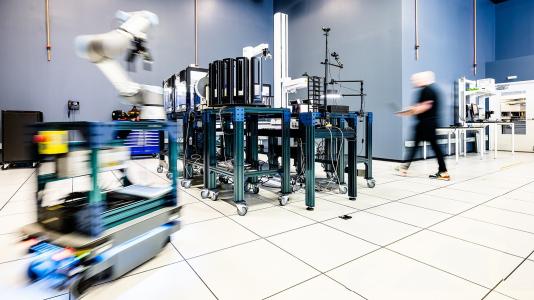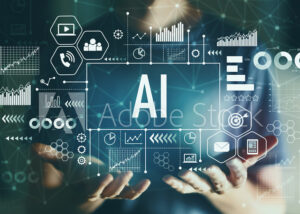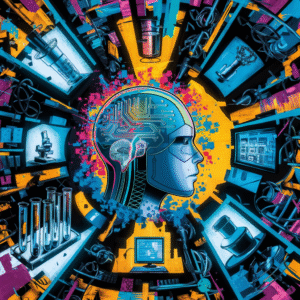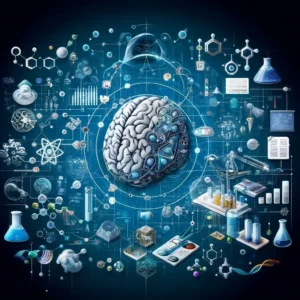Machine Learning for Scientific Discovery
Introduction
The quest for scientific discovery has always been driven by humanity’s curiosity to understand nature, the universe, and the principles that govern them. Traditionally, breakthroughs were achieved by painstaking experimentation, trial and error, and theoretical insight. However, in the 21st century, the rise of machine learning (ML) has transformed this process, enabling researchers to accelerate discovery, uncover hidden patterns, and even propose entirely new hypotheses.
Machine learning, a subset of artificial intelligence, is fundamentally about teaching machines to learn from data and make predictions or decisions without being explicitly programmed. In scientific contexts, this means allowing algorithms to sift through massive datasets, identify correlations, simulate models, and guide experimental directions. Today, ML is no longer just an auxiliary tool; it is becoming an integral partner in scientific inquiry.
This article explores in depth how machine learning is revolutionizing scientific discovery, its applications across disciplines, methodologies, challenges, ethical considerations, and future directions.
1. Evolution of Scientific Discovery and the Role of Data
Science has evolved through various stages:
-
Observation and Theory (Pre-20th century): Scientists relied heavily on observation, intuition, and mathematical reasoning.
-
Experimentation and Computation (20th century): Computers enabled simulations, large-scale experiments, and data analysis.
-
Data-Driven Discovery (21st century): Today, scientific research produces petabytes of data. Managing and interpreting this data exceeds human capacity, making ML indispensable.
Data Explosion in Science
Fields like genomics, astrophysics, and climate science generate terabytes of data daily. Traditional statistical methods, though powerful, often fall short in extracting deeper structures. ML’s ability to learn complex, nonlinear relationships has made it a new scientific method alongside theory, experiment, and simulation.
2. Foundations of Machine Learning for Science
Before diving into applications, it’s essential to understand how ML operates in the context of discovery.
Core ML Paradigms
-
Supervised Learning: Models learn from labeled datasets (e.g., predicting protein structures from sequences).
-
Unsupervised Learning: Algorithms discover hidden patterns without labels (e.g., clustering galaxies by morphology).
-
Reinforcement Learning: Agents learn strategies through trial and error (e.g., designing new molecules).
-
Self-Supervised Learning: Emerging paradigm enabling large models to learn structure from massive unlabeled datasets, crucial for areas like chemistry and physics.
Why ML Works for Science
-
Pattern Recognition: Identifying structures in noisy data.
-
High-Dimensional Data Handling: Managing thousands of variables simultaneously.
-
Predictive Modeling: Anticipating outcomes before running costly experiments.
-
Automation of Discovery: Accelerating hypothesis generation and experimental design.
3. Applications Across Scientific Disciplines
3.1 Physics
-
Particle Physics: ML algorithms process data from experiments like the Large Hadron Collider, identifying rare particle interactions.
-
Condensed Matter Physics: Deep learning predicts material properties and aids in designing superconductors.
-
Cosmology: ML accelerates galaxy classification, dark matter distribution mapping, and gravitational wave detection.
3.2 Chemistry
-
Drug Discovery: Generative models design candidate molecules with desired properties.
-
Quantum Chemistry: Neural networks approximate quantum mechanical simulations, reducing computation time.
-
Catalyst Design: ML models predict catalytic activity, guiding sustainable energy research.
3.3 Biology
-
Genomics: ML helps map gene functions, predict disease risks, and personalize medicine.
-
Protein Folding: DeepMind’s AlphaFold solved a 50-year-old biological challenge, predicting protein structures with unprecedented accuracy.
-
Synthetic Biology: Reinforcement learning designs genetic circuits and synthetic organisms.
3.4 Medicine
-
Medical Imaging: CNNs detect tumors, classify diseases, and outperform radiologists in some cases.
-
Precision Medicine: ML tailors treatments based on genetic, environmental, and lifestyle data.
-
Drug Repurposing: Models identify new uses for existing drugs, crucial during pandemics.
3.5 Earth and Environmental Science
-
Climate Modeling: ML enhances predictions of extreme weather events and climate change impacts.
-
Seismology: Algorithms detect earthquake precursors in seismic data.
-
Ecology: ML aids biodiversity mapping and conservation efforts using satellite imagery.
3.6 Astronomy
-
Exoplanet Discovery: ML analyzes telescope data to identify planetary transits.
-
Star Classification: Unsupervised clustering groups stars by properties.
-
Cosmic Event Detection: Algorithms detect gravitational lensing and rare cosmic explosions.
3.7 Materials Science
-
Materials Design: ML predicts stability and properties of new compounds.
-
Battery Research: Accelerates discovery of high-capacity, long-life materials.
-
Nanotechnology: Algorithms model nanoscale interactions, guiding innovations in electronics and medicine.
4. Methodologies Enabling Discovery
Deep Learning
Neural networks with many layers extract hierarchical representations, powering image analysis in astronomy, genomics, and medicine.
Generative Models
-
GANs (Generative Adversarial Networks): Create realistic simulations of molecules or cosmic structures.
-
VAEs (Variational Autoencoders): Generate novel molecular structures or new hypotheses.
Active Learning
Researchers use ML to decide which experiments to run next, reducing costs and accelerating discovery.
Physics-Informed ML
Integrates physical laws into models, ensuring predictions respect fundamental principles.
Transfer Learning
Knowledge gained in one domain (e.g., computer vision) is transferred to another (e.g., classifying microscopic images).
5. Case Studies in Scientific Discovery
Case Study 1: AlphaFold in Protein Science
DeepMind’s AlphaFold leveraged deep learning to predict protein folding, a grand challenge in biology. Its accuracy has transformed drug discovery, structural biology, and molecular medicine.
Case Study 2: ML in Astronomy
The Sloan Digital Sky Survey (SDSS) dataset is massive. ML models automatically classify galaxies, enabling cosmologists to study universe evolution without manually labeling millions of images.
Case Study 3: Climate Prediction
ML models enhance traditional climate models by refining local weather predictions and detecting early signals of extreme events like hurricanes.
Case Study 4: New Material Discovery
Researchers at MIT used ML to discover new materials for solar cells, accelerating the design cycle from decades to months.
6. Benefits of Machine Learning in Scientific Discovery
-
Acceleration of Research: Faster hypothesis testing and iteration.
-
Handling Big Data: Unlocks value from terabytes of experimental and observational data.
-
Cost Efficiency: Reduces need for expensive simulations and experiments.
-
Novel Hypotheses: Suggests new theories beyond human intuition.
-
Collaboration: Fosters human–machine partnerships in labs worldwide.
7. Challenges and Limitations
-
Interpretability: Many ML models are “black boxes,” making it hard to understand the reasoning behind predictions.
-
Bias in Data: Incomplete or biased datasets can lead to flawed conclusions.
-
Generalizability: Models trained in specific contexts may fail in new settings.
-
Data Scarcity: Some domains, like rare disease research, lack sufficient labeled data.
-
Integration with Theory: ML results must align with established scientific principles.
-
Ethical Concerns: Risk of misuse in sensitive areas like genetics or surveillance.
8. The Human–Machine Partnership
Machine learning is not replacing scientists—it is augmenting them. Human creativity, critical thinking, and theoretical insight remain irreplaceable. The future of discovery lies in collaborative intelligence, where algorithms handle complexity while humans provide interpretation and innovation.
9. Ethical and Philosophical Dimensions
-
Ownership of Discoveries: Who owns an AI-generated hypothesis or patent?
-
Accountability: Who is responsible if ML leads to harmful conclusions?
-
Epistemology of Science: Does ML represent a new “fourth paradigm” of science, where machines drive discovery beyond human comprehension?
10. Future Directions
-
Exascale Computing + ML: Combining ML with supercomputers will push boundaries in cosmology, quantum mechanics, and climate science.
-
Autonomous Labs: Robotic labs guided by ML will run experiments 24/7, accelerating discovery.
-
Cross-Disciplinary Breakthroughs: Unified ML frameworks will integrate data across physics, biology, and chemistry.
-
Explainable AI (XAI): Enhancing transparency in ML models for greater scientific trust.
-
Democratization of Discovery: Cloud-based ML platforms will allow global access, enabling researchers from developing countries to contribute.
Conclusion
Machine learning has become a transformative force in scientific discovery, ushering in a new era where data-driven insights complement theory and experimentation. From mapping the human genome to discovering new materials and unraveling cosmic mysteries, ML empowers scientists to solve complex problems faster and with greater precision.
Yet, this transformation also raises questions of trust, interpretability, and ethics. The most promising path forward is not replacing human scientists but amplifying their capabilities through intelligent systems. As machine learning becomes further integrated into scientific inquiry, the potential for groundbreaking discoveries grows exponentially—paving the way for innovations that may redefine the future of humanity.
Privacy-Preserving Machine Learning Techniques: Balancing Innovation with Data Protection







